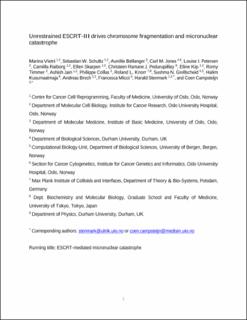Unrestrained ESCRT-III drives micronuclear catastrophe and chromosome fragmentation
Vietri, Marina; Schultz, Sebastian; Bellanger, Aurélie Nathalie Pascale; Jones, Carl; Petersen, Louise I; Raiborg, Camilla; Skarpen, Ellen; Pedurupillay Jesuthasan, Christeen Ramane; Kjos, Ingrid; Kip, Eline; Timmer, Ronny; Jain, Ashish; Collas, Philippe; Knorr, Roland; Grellscheid, Sushma; Kusumaatmaja, Halim; Brech, Andreas; Micci, Francesca; Stenmark, Harald Alfred; Campsteijn, Coen
Journal article, Peer reviewed
Accepted version
Permanent lenke
https://hdl.handle.net/11250/2771767Utgivelsesdato
2020Metadata
Vis full innførselSamlinger
- Department of Biological Sciences [2235]
- Registrations from Cristin [9791]
Sammendrag
The ESCRT-III membrane fission machinery maintains the integrity of the nuclear envelope. Although primary nuclei resealing takes minutes, micronuclear envelope ruptures seem to be irreversible. Instead, micronuclear ruptures result in catastrophic membrane collapse and are associated with chromosome fragmentation and chromothripsis, complex chromosome rearrangements thought to be a major driving force in cancer development. Here we use a combination of live microscopy and electron tomography, as well as computer simulations, to uncover the mechanism underlying micronuclear collapse. We show that, due to their small size, micronuclei inherently lack the capacity of primary nuclei to restrict the accumulation of CHMP7–LEMD2, a compartmentalization sensor that detects loss of nuclear integrity. This causes unrestrained ESCRT-III accumulation, which drives extensive membrane deformation, DNA damage and chromosome fragmentation. Thus, the nuclear-integrity surveillance machinery is a double-edged sword, as its sensitivity ensures rapid repair at primary nuclei while causing unrestrained activity at ruptured micronuclei, with catastrophic consequences for genome stability.
